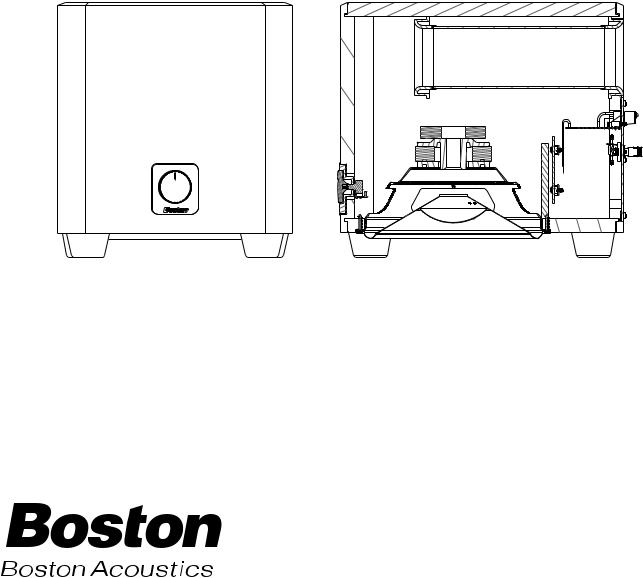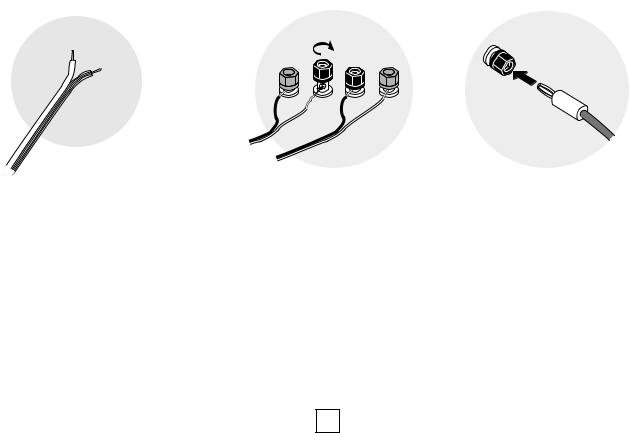Boston Acoustics PV700, PV900 User Manual



 PV900 PV700
PV900 PV700
Powered Subwoofers

Important Safety Instructions
This symbol found on the apparatus indicates hazards arising from dangerous voltages.
This symbol found on the apparatus indicates the user should read all safety statements found in the user manual.
This symbol found on the apparatus indicates double insulation.
WARNING! To reduce the risk of fire or electric shock, do not expose this product to rain or moisture.
1.Read these instructions.
2.Keep these instructions.
3.Heed all warnings.
4.Follow all instructions.
5.Do not use this apparatus near water.
6.Clean only with dry cloth.
7.Do not block any ventilation openings. Install in accordance with the manufacturer's instructions.
8.Do not install near any heat sources such as radiators, heat registers, stoves, or other apparatus (including amplifiers) that produce heat.
9.Do not defeat the safety purpose of the polarized or grounding-type plug. A polarized plug has two blades with one wider than the other. A grounding type plug has two blades and a third grounding prong. The wide blade or the third prong are provided for your safety. If the provided plug does not fit into your outlet, consult an electrician for replacement of the obsolete outlet.
10.Protect the power cord from being walked on or pinched particularly at plugs, convenience receptacles, and the point where they exit from the apparatus.
11.Only use attachments/accessories specified by the manufacturer.
12.Unplug this apparatus during lightning storms or when unused for long periods of time.
13.Refer all servicing to qualified service personnel. Servicing is required when the apparatus has been damaged in any way, such as power-supply cord or plug is damaged, liquid has been spilled or objects have fallen into the apparatus, the apparatus has been exposed to rain or moisture, does not operate normally, or has been dropped.
14.Maintain a minimum distance of 50 mm around the front, rear and sides of the apparatus for sufficient ventilation. The ventilation should not be impeded by covering the ventilation openings or placing on or around the apparatus items such as newspapers, table-cloths, curtains, etc.
15.No naked flame sources, such as lighted candles, should be placed on the apparatus.
16The apparatus shall not be exposed to dripping or splashing. No objects filled with liquids, such as vases, shall be placed on the apparatus.
17. The apparatus is suitable for use in tropical and/or moderate climates.
2

Specifications*
PV900 |
PV700 |
|
|
Frequency Response (±3dB) 26–150Hz |
29–150Hz |
|
|
Subwoofer Amplifier Power FTC Rated Power: 300 watts @ 50 Hz into 4 ohms at less than 1% THD+N
FTC Rated Power: 200 watts @ 50 Hz into 4 ohms at less than 1% THD+N
Subwoofer Crossover |
50–150Hz |
50–150Hz |
|
24dB/octave low-pass |
24dB/octave low-pass |
|
|
|
LFE Input |
Yes |
Yes |
|
|
|
Crossover Bypass |
Yes |
Yes |
|
|
|
Bass Unit |
12" (305mm) DCD |
12" (305mm) DCD |
|
down-firing |
down-firing |
|
|
|
Enclosure Type |
Rear-ported |
Rear-ported |
|
|
|
Dimensions (HxWxD) |
155/8 x 141/2 x 171/2" |
141/4 x 131/2 x 163/4" |
(with feet and |
(397 x 369 x 445mm) |
(362 x 343 x 426mm) |
rear connectors) |
|
|
|
|
|
Weight |
32 lbs (14.4kg) |
28 lbs (12.6kg) |
|
|
|
Finish |
Black ash vinyl veneer |
Black ash vinyl veneer |
|
|
|
*In keeping with our policy of continual product improvements, specifications are subject to change without notice. Please visit our web page, www.bostonacoustics.com, for the latest specifications on these two products.
Description
Boston’s PV700 and PV900 subwoofers deliver the dynamic bass foundation that is essential for lifelike reproduction of movie soundtracks and music in the home. These attractive powered subwoofers will complement any stereo or home theater surround sound system with their impressive bass output and compact size.
Both subwoofers utilize our rugged DCD™ (Deep Channel Design) bass unit designed in Boston’s state-of-the-art engineering facility in Peabody, Massachusetts. Every one is tested as it comes off the line to be within ±1dB of the lab reference unit, an incredibly tight tolerance. The amplifiers have built-in variable crossovers that allow them to easily achieve a seamless blend with the main speakers, while a 24dB/octave low-pass filter prevents the subwoofers from being easily localized by ear, increasing placement flexibility. A crossover bypass function is provided for use with home theater electronics that perform their own bass management.
Because of their high-powered amplifiers and computer-optimized tunings, the PV700 and PV900 are capable of impressive deep bass and high output from remarkably compact enclosures. In addition, they feature BassTrac®, a proprietary Boston-designed circuit that tracks the input signal to the subwoofer and prevents its amplifier from being driven into audible distortion. The benefit: The bass stays clean and strong at any listening level.
Auto on-off amplifier switching and easily accessible controls make the PV700 and PV900 subwoofers as convenient to use as they are exciting to listen to.
3

Connections
NOTE: Power is always supplied to the subwoofer electronics unless it is unplugged or switched to the off position using the power toggle switch located in the lower left corner of the rear panel. The auto-on circuitry only activates or deactivates the power amplifier. Make sure your subwoofer and receiver are unplugged when making the connection.
Line level: Use one of the “line level in” jacks with most systems. These inputs accept the line-level signal from your receiver’s subwoofer output. When using the “use crossover control” input, the subwoofer’s circuitry filters out the high frequencies and sends the remaining low frequencies to the subwoofer power amplifier.
Speaker level: Use these high-level terminals with receivers that do not have subwoofer output. The speaker inputs accept both left and right channel speaker signals from your receiver. NOTE: Certain receivers use speaker grounding circuits that may be incompatible with external powered audio products, such as powered subwoofers. When speaker wire is used instead of line level cables, this incompatibility can sometimes result in an audible hum when the receiver is turned off or switched to a different speaker channel. See page 8 for more information.
How to Connect Using the Speaker Terminals
We recommend 18-gauge wire or thicker for runs up to 15 feet (4.5m), and 16-gauge wire or thicker for longer runs. Separate the first few inches of the wire conductors. Strip off 1⁄ 2-inch (12mm) of insulation from the ends of each speaker wire to expose the two conductors and tightly twist the wire strands.
WARNING: To prevent electrical shock hazard, always switch off the amplifier or receiver when making connections to the speaker.
When making all connections, be sure to connect the + (red) on the speaker to the + (red) on the amplifier, and the – (black) on the speaker to the – (black) on the amplifier.
–
+
IMPORTANT: Typically, one side of the wire is smooth. Connect this side to the – (black) connection. The other side has a rib or stripe. Connect this to the + (red) connection.
Using the five-way binding posts: The binding posts permit easy connection to banana plugs, spade lugs, and bare wire. Insert the wire in the hole (as shown on left) or a 3/8-inch spade lug over the post and tighten. For banana plugs, remove the red and black caps from the end-holes and insert either dual or single banana plugs (as shown on right).
Using This Manual – PV700 versus PV900
NOTE: The rear amplifier panels of the PV700 and the PV900 are virtually the same. Although the instructional images on the following pages depict the PV700’s rear panel, the PV900 connects, functions and operates in exactly the same manner.
4
